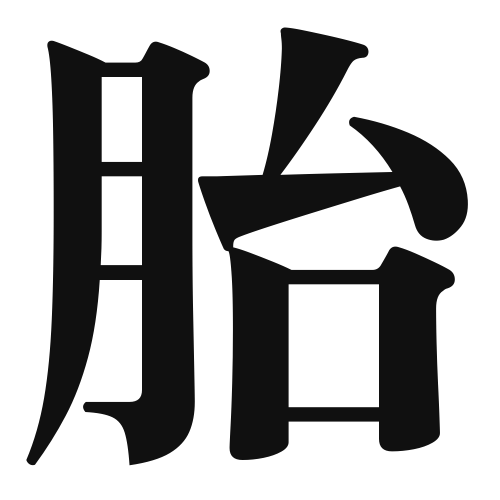1. Overview of Meaning
The kanji “胎” (tai) primarily means “womb” or “uterus.” It is often associated with concepts of birth, nurturing, and the beginning of life.
2. Formation and Radical
Formation of the Kanji: The kanji “胎” is a phonetic-ideographic character (形声文字). It combines the meaning of the radical and a phonetic component. The left part, “月,” represents flesh or body, while the right part, “台,” contributes to the pronunciation.
Radical: The radical for “胎” is “月” (which can also mean “flesh” or “body”), indicating its connection to physicality and life.
3. Examples of Usage
Common Words and Phrases:
- 胎児 (taiji) – fetus
- 胎内 (tainai) – inside the womb
Example Sentences in Daily Conversation:
- 彼女は胎児の健康を気にしています。 (Kanojo wa taiji no kenkou o ki ni shiteimasu.) – She is concerned about the health of the fetus.
- 胎内での成長は非常に重要です。 (Tainai de no seichou wa hijou ni juuyou desu.) – Growth in the womb is very important.
4. Synonyms and Antonyms
Similar Kanji:
- 生 (sei) – life; this kanji emphasizes the aspect of living, while “胎” focuses on the womb and the nurturing aspect.
Antonyms:
- 死 (shi) – death; this kanji represents the opposite of life and birth, contrasting with the nurturing connotation of “胎.”
5. Cultural and Historical Background
Relation to Japanese Culture: The concept of “胎” is deeply rooted in Japanese culture, where the womb is often seen as a sacred space for nurturing life. It reflects the importance of family and continuity in Japanese society.
Proverbs and Idioms: There are various proverbs related to birth and nurturing, such as “母は強し” (Haha wa tsuyoshi – A mother is strong), which emphasizes the strength and resilience of mothers, often linked to the idea of “胎.”
